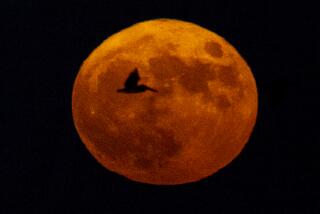Tonight, Jupiter and Venus meet in a summer sky
It’s been a slow summer dance as Venus and Jupiter have sidled up to one another over the month of June, but tonight is the night of the big rendezvous: Conjunction, when the two planets will appear close enough in the night sky to kiss.
Amateur astronomers will be pulling out their telescopes, but you don’t need any fancy equipment to view it. Just look to the west: The two planets will be so bright in the sky that you should be able to see them with the naked eye even during the fading twilight glow.
From our vantage point on Earth, the two planets will be just one-third of a degree apart — which is less than the diameter of the full moon, according to NASA. Jupiter can be seen just above the gleaming spot that is Venus. They also will appear to be roughly the same size.
Both are illusions, of course: Venus is our nearest neighbor, sitting closer to the sun, and Jupiter sits far out in the solar system, at roughly five times the distance from the sun to the Earth. Because the one-eyed gas giant is so far away, it appears smaller — which is why it can look comparable to Venus, which is roughly the size of Earth.
(That’s also the same reason the moon can cover the sun, giving us a perfect solar eclipse — though it won’t do that forever, as the moon is slowly drifting away from the Earth and, in perhaps several hundred million years, potentially could appear too small to completely cover the disc of the sun.)
Planets often meet one another in the night sky: In October, Jupiter, Mars and Venus will form the year’s closest planetary threesome, according to EarthSky. Tonight, however, will offer the closest conjunction between Venus and Jupiter until August 2016.
You can see what tonight’s conjunction may look like in the NASA video above.
Still waiting for the planets to align? Follow @aminawrite for more science news.
ALSO:
‘Leap second’: Why June 30 will have one extra second
NASA spies strange lone ‘pyramid’ on dwarf planet Ceres
SpaceX rocket failure raises questions about space station’s vital supplies







